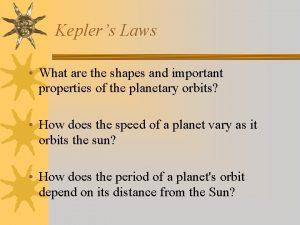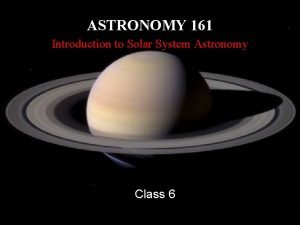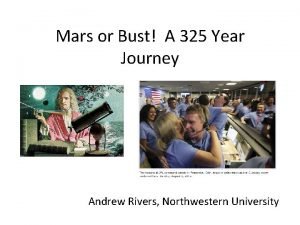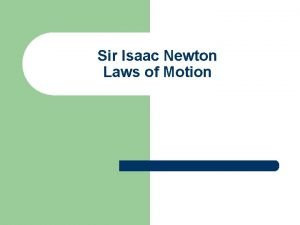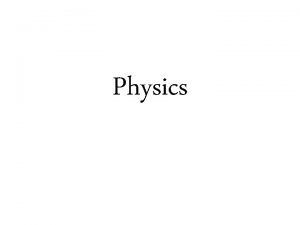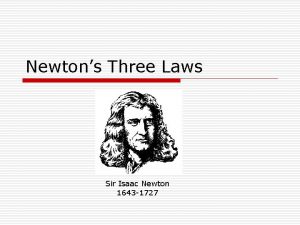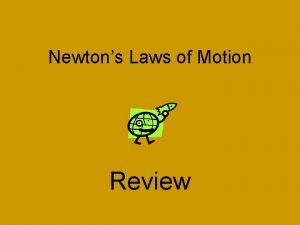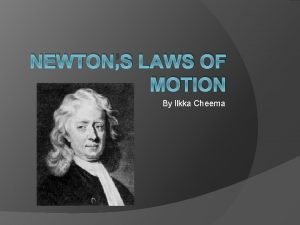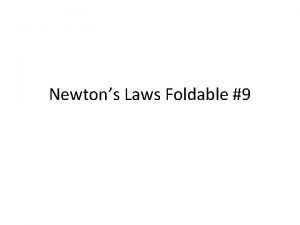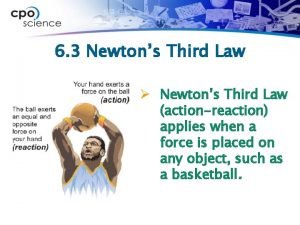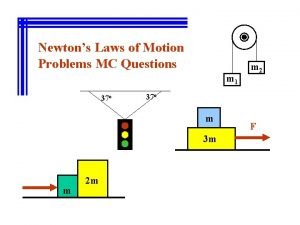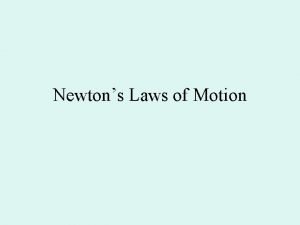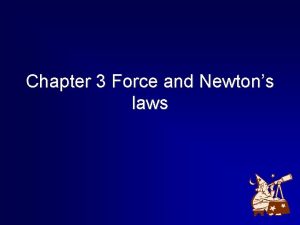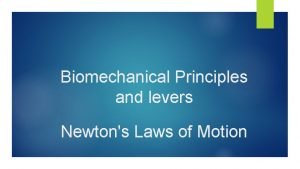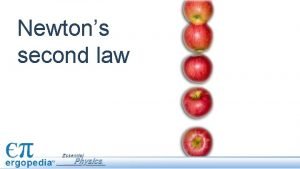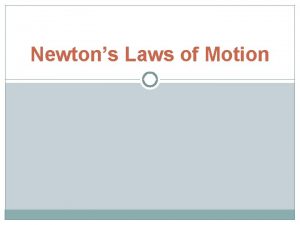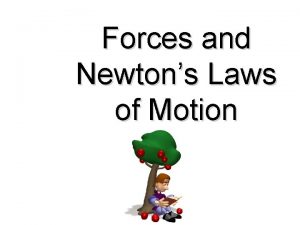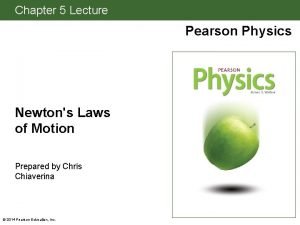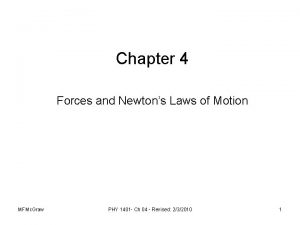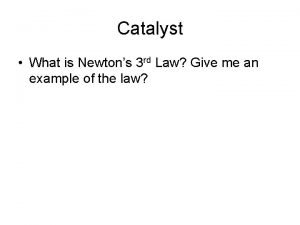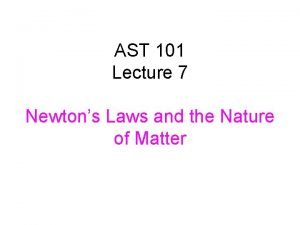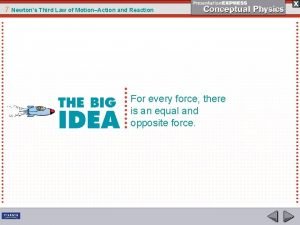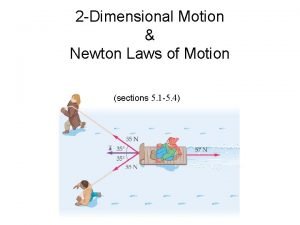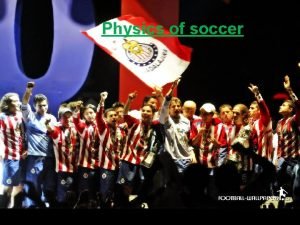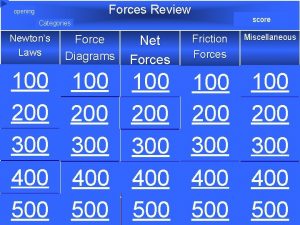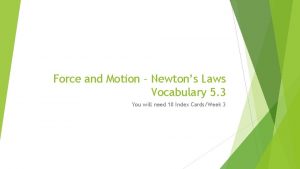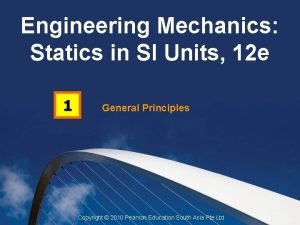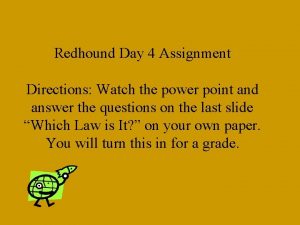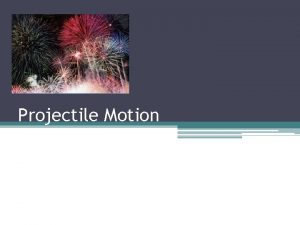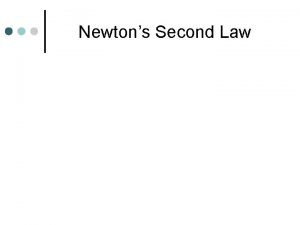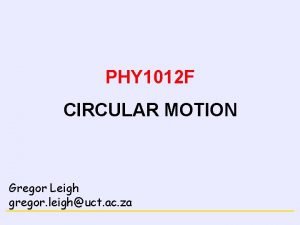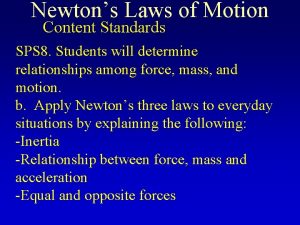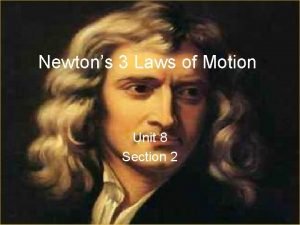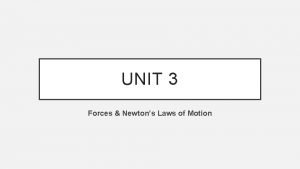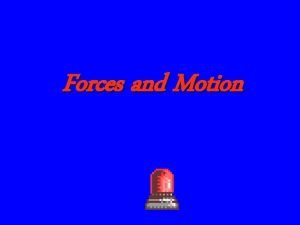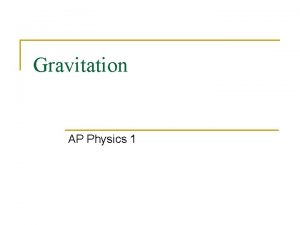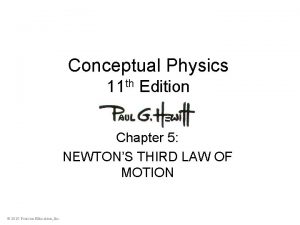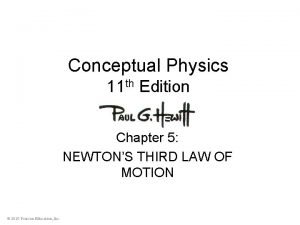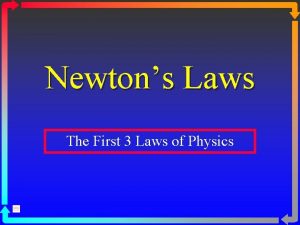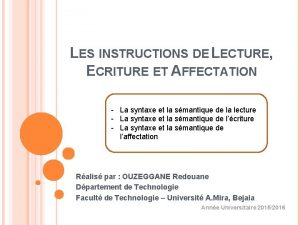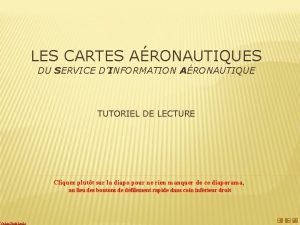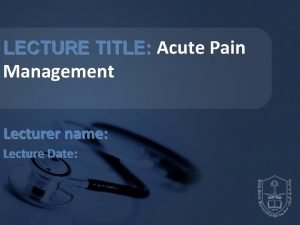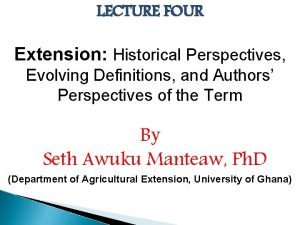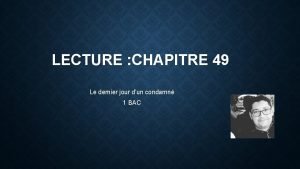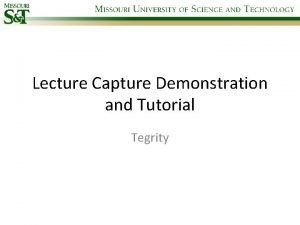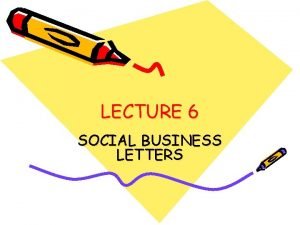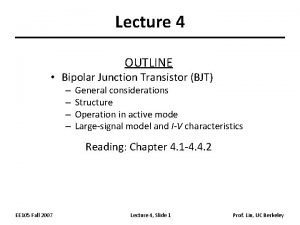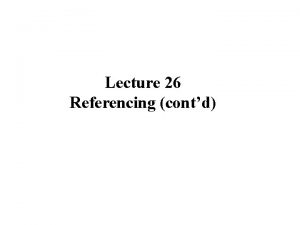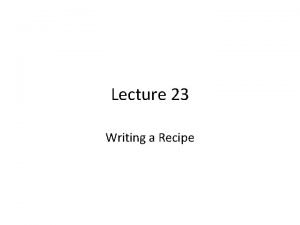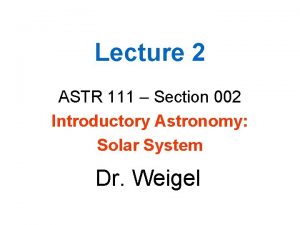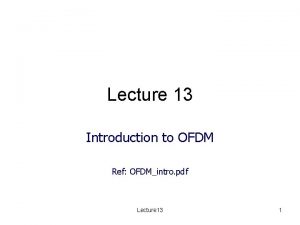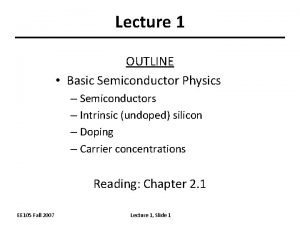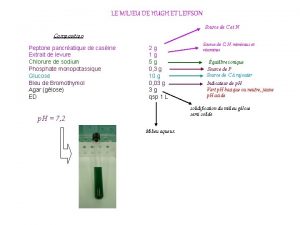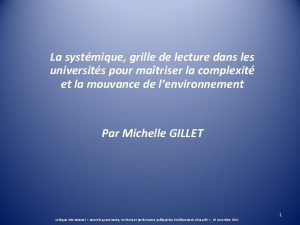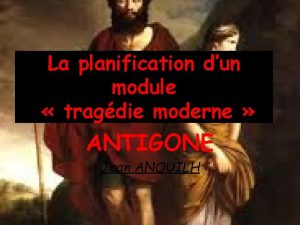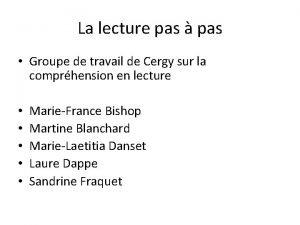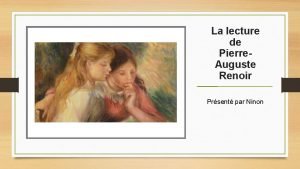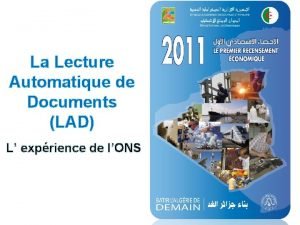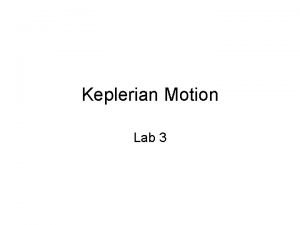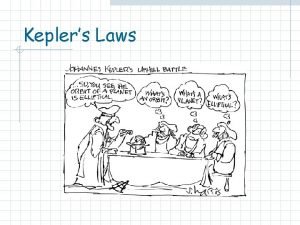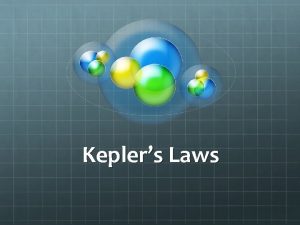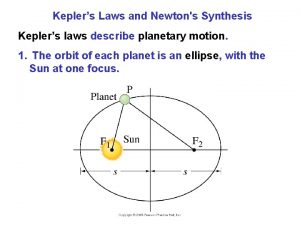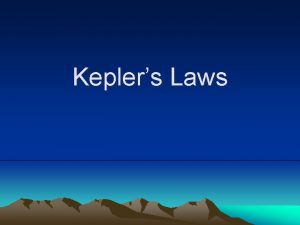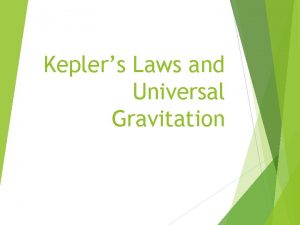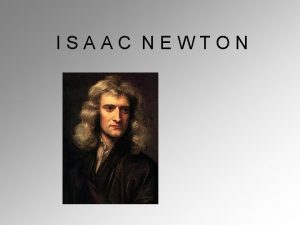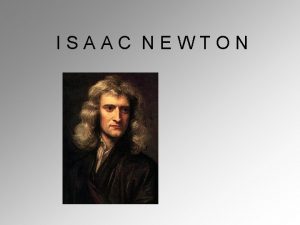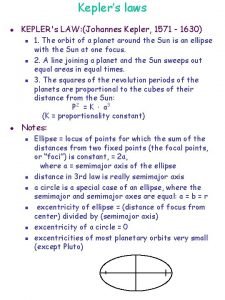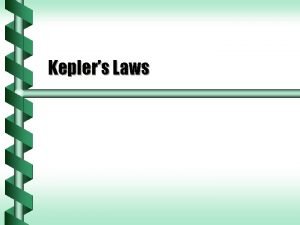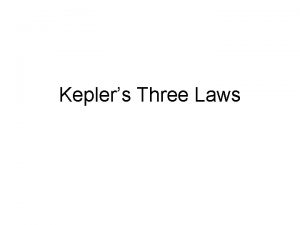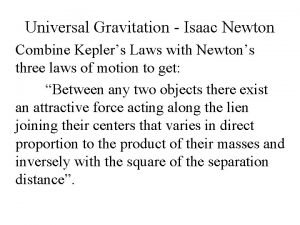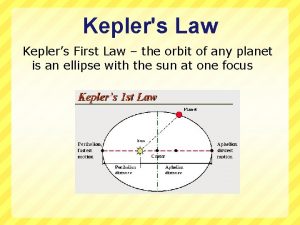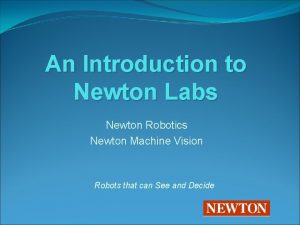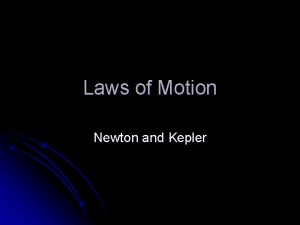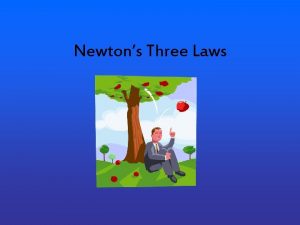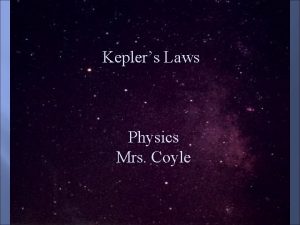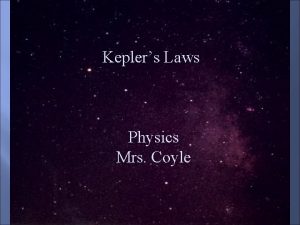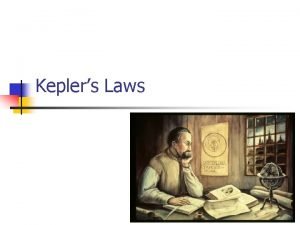3 Lecture in physics Newton Laws Keplers laws
























































































































- Slides: 120

3 Lecture in physics Newton Laws Kepler's laws Friction Rotation Moment Oscillations Waves Deformation Fluid

Homework and other questions

Missed: • • Set theory Arithmetic equivalents of logical operations Average value of a continuous function Substitution and by parts integration

Theoretical mechanics Analytical mechanics (or theoretical mechanics), developed in the 18 th century and onward, are mathematical physics' refinements of classical mechanics, originally Newtonian mechanics, often termed vectorial mechanics. To model motion, analytical mechanics uses two scalar properties of motion—its kinetic energy and its potential energy—not Newton's vectorial forces. (A scalar is represented by a quantity, as denotes intensity, whereas a vector is represented by quantity plus direction. ) Principally Lagrangian mechanics and Hamiltonian mechanics, both tightly intertwined, analytical mechanics efficiently extends the scope of classical mechanics to solve problems by employing the concept of a system's constraints and path integrals. Using these concepts, theoretical physicists— such as Schrödinger, Dirac, Heisenberg and Feynman—developed quantum mechanics and its elaboration, quantum field theory. Applications and extensions reach into Einstein's general relativity as well as chaos theory. A very general result from analytical mechanics is Noether's theorem, which fuels much of modern theoretical physics.

Classical mechanics: v << c = 3 × 108 and D >> h = 1. 5 × 10 -35 (D > 0. 000001) c is the speed of light in vacuum h is Planck’s length Time and mass limits are also applicable.

Mass center The center of mass of a distribution of mass in space is the unique point where the weighted relative position of the distributed mass sums to zero. The distribution of mass is balanced around the center of mass and the average of the weighted position coordinates of the distributed mass defines its coordinates. Calculations in mechanics are often simplified when formulated with respect to the center of mass.

Internal forces

Internal forces cannot move the center of mass of a mechanical system.

Internal forces contribute to change of kinetic energy of mechanical system.

Kinetic energy change theorem Change in kinetic energy of mechanical system is equal to work of the internal and the external forces.


Linear momentum (continued) Linear momentum or translational momentum (pl. momenta; SI unit kg m/s, or equivalently, N s) is the product of the mass and velocity of an object. For example, a heavy truck moving quickly has a large momentum—it takes a large or prolonged force to get the truck up to this speed, and it takes a large or prolonged force to bring it to a stop afterwards. If the truck were lighter, or moving more slowly, then it would have less momentum.

Linear momentum

Inertia is the resistance of any physical object to any change in its state of motion, including changes to its speed and direction. It is the tendency of objects to keep moving in a straight line at constant velocity. The principle of inertia is one of the fundamental principles of classical physics that are used to describe the motion of objects and how they are affected by applied forces. Inertia comes from the Latin word, iners, meaning idle, sluggish. Inertia is one of the primary manifestations of mass, which is a quantitative property of physical systems.

Newton's laws of motion are three physical laws that together laid the foundation for classical mechanics. They describe the relationship between a body and the forces acting upon it, and its motion in response to said forces.

Newton's laws of motion (continued) They have been expressed in several different ways over nearly three centuries, and can be summarised as follows: 1. First law: When viewed in an inertial reference frame, an object either remains at rest or continues to move at a constant velocity, unless acted upon by an external force. [2][3] 2. Second law: F=ma. The vector sum of the forces F on an object is equal to the mass m of that object multiplied by the acceleration vector a of the object. 3. Third law: When one body exerts a force on a second body, the second body simultaneously exerts a force equal in magnitude and opposite in direction on the first body.

(continued) Newton's laws of motion The three laws of motion were first compiled by Isaac Newton in his Philosophiæ Naturalis Principia Mathematica (Mathematical Principles of Natural Philosophy), first published in 1687. Newton used them to explain and investigate the motion of many physical objects and systems. For example, in the third volume of the text, Newton showed that these laws of motion, combined with his law of universal gravitation, explained Kepler's laws of planetary motion.

Newton's laws of motion




mv = Ft

Newton's law of universal gravitation states that any two bodies in the universe attract each other with a force that is directly proportional to the product of their masses and inversely proportional to the square of the distance between them. (Separately it was shown that large spherically symmetrical masses attract and are attracted as if all their mass were concentrated at their centers. ) (Similar to Coulomb Law)

Newton's law of universal gravitation

G = 6. -11 2 673× 10 N(m/kg)

Kepler's laws of planetary motion are three scientific laws describing the motion of planets around the Sun. Kepler's laws are now traditionally enumerated in this way: 1. The orbit of a planet is an ellipse with the Sun at one of the two foci. 2. A line segment joining a planet and the Sun sweeps out equal areas during equal intervals of time. 3. The square of the orbital period of a planet is proportional to the cube of the semi-major axis of its orbit.




Perpetual motion is motion that continues indefinitely without any external source of energy. This is impossible in practice because of friction and other sources of energy loss. A perpetual motion machine is a hypothetical machine that can do work indefinitely without an energy source. This kind of machine is impossible, as it would violate the first or second law of thermodynamics.

Friction • Static friction (sliding) • Kinetic friction (sliding) • Rolling resistance

Friction (continued) Friction is the force resisting the relative motion of solid surfaces, fluid layers, and material elements sliding against each other.


Inclined plane An inclined plane is a flat supporting surface tilted at an angle, with one end higher than the other, used as an aid for raising or lowering a load. The inclined plane is one of the six classical simple machines defined by Renaissance scientists. Inclined planes are widely used to move heavy loads over vertical obstacles; examples vary from a ramp used to load goods into a truck, to a person walking up a pedestrian ramp, to an automobile or railroad train climbing a grade.


Rolling resistance, sometimes called rolling friction or rolling drag, is the force resisting the motion when a body (such as a ball, tire, or wheel) rolls on a surface. It is mainly caused by non-elastic effects; that is, not all the energy needed for deformation (or movement) of the wheel, roadbed, etc. is recovered when the pressure is removed. Two forms of this are hysteresis losses (see below), and permanent (plastic) deformation of the object or the surface (e. g. soil). Another cause of rolling resistance lies in the slippage between the wheel and the surface, which dissipates energy. Note that only the last of these effects involves friction, therefore the name "rolling friction" is to an extent a misnomer.

Rolling resistance (continued) In analogy with sliding friction, rolling resistance is often expressed as a coefficient times the normal force. This coefficient of rolling resistance is generally much smaller than the coefficient of sliding friction.

Rolling resistance (continued) Any coasting wheeled vehicle will gradually slow down due to rolling resistance including that of the bearings, but a train car with steel wheels running on steel rails will roll farther than a bus of the same mass with rubber tires running on tarmac. Factors that contribute to rolling resistance are the (amount of) deformation of the wheels, the deformation of the roadbed surface, and movement below the surface. Additional contributing factors include wheel diameter, speed, load on wheel, surface adhesion, sliding, and relative micro-sliding between the surfaces of contact. The losses due to hysteresis also depend strongly on the material properties of the wheel or tire and the surface. For example, a rubber tire will have higher rolling resistance on a paved road than a steel railroad wheel on a steel rail. Also, sand on the ground will give more rolling resistance than concrete.

Vector Euclidean vector, a geometric entity endowed with magnitude and direction as well as a positive-definite inner product; an element of a Euclidean vector space. In physics, Euclidean vectors are used to represent physical quantities that have both magnitude and direction, such as force, in contrast to scalar quantities, which have no direction.

Radius vector A position or position vector, also known as location vector or radius vector, is a Euclidean vector that represents the position of a point P in space in relation to an arbitrary reference origin O. Usually denoted x, r, or s, it corresponds to the straight line distance from O to P.


Dot product The dot product, or scalar product (or sometimes inner product in the context of Euclidean space), is an algebraic operation that takes two equal-length sequences of numbers (usually coordinate vectors) and returns a single number. This operation can be defined either algebraically or geometrically. Algebraically, it is the sum of the products of the corresponding entries of the two sequences of numbers. Geometrically, it is the product of the Euclidean magnitudes of the two vectors and the cosine of the angle between them. The name "dot product" is derived from the centered dot " · " that is often used to designate this operation; the alternative name "scalar product" emphasizes the scalar (rather than vectorial) nature of the result. In three-dimensional space, the dot product contrasts with the cross product of two vectors, which produces a pseudovector as the result. The dot product is directly related to the cosine of the angle between two vectors in Euclidean space of any number of dimensions.


Cross product Vector product, or cross product, an operation on two vectors in a three-dimensional Euclidean space, producing a third three-dimensional Euclidean vector.


Angular momentum, moment of momentum, or rotational momentum is a measure of the amount of rotation an object has, taking into account its mass, shape and speed. It is a vector quantity that represents the product of a body's rotational inertia and rotational velocity about a particular axis. The angular momentum of a system of particles (e. g. a rigid body) is the sum of angular momenta of the individual particles.


For a general rotation of a rigid body around one fixed point we consider the sequence of instantaneous axes of rotation. This brings us to inertia tensor, which means the tensor of the moments of inertia.

Angular momentum applications: • Gyroscopes • Earth rotation detection pendulum

Matrix multiplication is a binary operation that takes a pair of matrices, and produces another matrix. Numbers such as the real or complex numbers can be multiplied according to elementary arithmetic. On the other hand, matrices are arrays of numbers, so there is no unique way to define "the" multiplication of matrices. As such, in general the term "matrix multiplication" refers to a number of different ways to multiply matrices. The key features of any matrix multiplication include: the number of rows and columns the original matrices have (called the "size", "order" or "dimension"), and specifying how the entries of the matrices generate the new matrix.

Momentum conservation One of the most powerful laws in physics is the law of momentum conservation.


Collision A collision is an isolated event in which two or more moving bodies (colliding bodies) exert forces on each other for a relatively short time. Although the most common colloquial use of the word "collision" refers to accidents in which two or more objects collide, the scientific use of the word "collision" implies nothing about the magnitude of the forces.

Linear momentum is conserved for perfectly elastic and perfectly inelastic collisions.

Moment A moment is a rotational effect of a force.

Moment (continued) Moment is a combination of a physical quantity and a distance. Moments are usually defined with respect to a fixed reference point; they deal with physical quantities as measured at some distance from that reference point. For example, a moment of force is the product of a force and its distance from an axis, which causes rotation about that axis.


Mechanics main rule (Lever)


Superposition principle The superposition principle, also known as superposition property, states that, for all linear systems, the net response at a given place and time caused by two or more stimuli is the sum of the responses which would have been caused by each stimulus individually. So that if input A produces response X and input B produces response Y then input (A + B) produces response (X + Y).

Static equilibrium A mechanical equilibrium is a state in which a momentum coordinate of a particle, rigid body, or dynamical system is conserved. Usually this refers to linear momentum. For instance, a linear mechanical equilibrium would be a state in which the linear momentum of the system is conserved as the net force on the object is zero. In the specific case that the linear momentum is zero and conserved, the system can be said to be in a static equilibrium although for any system in which the linear momentum is conserved, it is possible to shift to a non-inertial reference frame that is stationary with respect to the object. In a rotational mechanical equilibrium the angular momentum of the object is conserved and the net torque is zero. More generally in conservative systems, equilibrium is established at a point in configuration space where the gradient with respect to the generalized coordinates of the potential energy is zero.


Block-stacking problem The block-stacking problem (also the bookstacking problem, or a number of other similar terms) is the following puzzle: Place rigid rectangular blocks in a stable stack on a table edge in such a way as to maximize the overhang.


Rotation A rotation is a circular movement of an object around a center (or point) of rotation. A threedimensional object always rotates around an imaginary line called a rotation axis. If the axis passes through the body's center of mass, the body is said to rotate upon itself, or spin. A rotation about an external point, e. g. the Earth about the Sun, is called a revolution or orbital revolution, typically when it is produced by gravity.


Translation vs. rotation (comparison)

Translation and rotation combination

Energy in mechanics Mechanical energy is the sum of potential energy and kinetic energy. It is the energy associated with the motion and position of an object. The principle of conservation of mechanical energy states that in an isolated system that is only subject to conservative forces the mechanical energy is constant. If an object is moved in the opposite direction of a conservative net force, the potential energy will increase and if the speed (not the velocity) of the object is changed, the kinetic energy of the object is changed as well. In all real systems, however, non-conservative forces, like frictional forces, will be present, but often they are of negligible values and the mechanical energy's being constant can therefore be a useful approximation. In elastic collisions, the mechanical energy is conserved but in inelastic collisions, some mechanical energy is converted into heat. The equivalence between lost mechanical energy (dissipation) and an increase in temperature was discovered by James Prescott Joule.

Conservation of energy The law of conservation of energy states that the total energy of an isolated system cannot change—it is said to be conserved over time. Energy can be neither created nor destroyed, but can change form, for instance chemical energy can be converted to kinetic energy in the explosion of a stick of dynamite. A consequence of the law of conservation of energy is that a perpetual motion machine of the first kind cannot exist. That is to say, no system without an external energy supply can deliver an unlimited amount of energy to its surroundings.

Conservation of energy Energy conservation is the most important in all physics: thermodynamics, electricity, relativity, quantum physics, particle physics, etc.


Conservation laws are true for conservative forces.

Conservative force A conservative force is a force with the property that the work done in moving a particle between two points is independent of the taken path. Equivalently, if a particle travels in a closed loop, the net work done (the sum of the force acting along the path multiplied by the distance travelled) by a conservative force is zero. A conservative force is dependent only on the position of the object. If a force is conservative, it is possible to assign a numerical value for the potential at any point. When an object moves from one location to another, the force changes the potential energy of the object by an amount that does not depend on the path taken. If the force is not conservative, then defining a scalar potential is not possible, because taking different paths would lead to conflicting potential differences between the start and end points. Gravity is an example of a conservative force, while friction is an example of a non-conservative force.

Conservative force (continued) F = grad(p)

Conservation laws as results of symmetry of space-time (homogeneous and isotropic)

Deformation is a change in the shape or size of an object due to: 1. an applied force (the deformation energy in this case is transferred through work) or 2. a change in temperature (the deformation energy in this case is transferred through heat).


Elasticity (from Greek ἐλαστός "ductible") is the tendency of solid materials to return to their original shape after being deformed. Solid objects will deform when forces are applied on them. If the material is elastic, the object will return to its initial shape and size when these forces are removed.


Hooke's Law Hooke's law is a principle of physics that states that the force F needed to extend or compress a spring by some distance X is proportional to that distance. That is: F = k. X, where k is a constant factor characteristic of the spring, its stiffness. The law is named after 17 th century British physicist Robert Hooke. He first stated the law in 1660 as a Latin anagram. He published the solution of his anagram in 1678 as: ut tensio, sic vis ("as the extension, so the force" or "the extension is proportional to the force").


Oscillation is the repetitive variation, typically in time, of some measure about a central value (often a point of equilibrium) or between two or more different states. Familiar examples include a swinging pendulum and alternating current power. The term vibration is sometimes used more narrowly to mean a mechanical oscillation but is sometimes used as a synonym of "oscillation". Oscillations occur not only in mechanical systems but also in dynamic systems in virtually every area of science: for example the beating human heart, business cycles in economics, predator-prey population cycles in ecology, geothermal geysers in geology, vibrating strings in musical instruments, periodic firing of nerve cells in the brain, and the periodic swelling of Cepheid variable stars in astronomy.


Vibration is a mechanical phenomenon whereby oscillations occur about an equilibrium point. The oscillations may be periodic such as the motion of a pendulum or random such as the movement of a tire on a gravel road. Vibration is occasionally "desirable". For example, the motion of a tuning fork, the reed in a woodwind instrument or harmonica, or mobile phones or the cone of a loudspeaker is desirable vibration, necessary for the correct functioning of the various devices. More often, vibration is undesirable, wasting energy and creating unwanted sound – noise. For example, the vibrational motions of engines, electric motors, or any mechanical device in operation are typically unwanted. Such vibrations can be caused by imbalances in the rotating parts, uneven friction, the meshing of gear teeth, etc. Careful designs usually minimize unwanted vibrations. The study of sound and vibration are closely related. Sound, or "pressure waves", are generated by vibrating structures (e. g. vocal cords); these pressure waves can also induce the vibration of structures (e. g. ear drum). Hence, when trying to reduce noise it is often a problem in trying to reduce vibration. One of the possible modes of vibration of a circular drum (see other modes). Car Suspension: designing vibration control is undertaken as part of acoustic, automotive or mechanical engineering.


Resonance is the tendency of a system to oscillate with greater amplitude at some frequencies than at others. Frequencies at which the response amplitude is a relative maximum are known as the system's resonant frequencies, or resonance frequencies. At these frequencies, even small periodic driving forces can produce large amplitude oscillations, because the system stores vibrational energy.

Eigenvalues and eigenvectors An eigenvector of a square matrix A is a nonzero vector v that, when the matrix multiplies v, yields a constant multiple of v, the latter multiplier being commonly denoted by L: Av = Lv

Waves in mechanics A wave is disturbance or oscillation that travels through matter or space, accompanied by a transfer of energy. Wave motion transfers energy from one point to another, often with no permanent displacement of the particles of the medium—that is, with little or no associated mass transport. They consist, instead, of oscillations or vibrations around almost fixed locations. Waves are described by a wave equation which sets out how the disturbance proceeds over time. The mathematical form of this equation varies depending on the type of wave.

Waves in mechanics (continued) A mechanical wave is a wave that propagates as an oscillation of matter, and therefore transfers energy through a medium. While waves can move over long distances, the movement of the medium of transmission —the material—is limited. Therefore, oscillating material does not move far from its initial equilibrium position. Mechanical waves transport energy only. This energy propagates in the same direction as the wave. Any kind of wave (mechanical or electromagnetic) has a certain energy. No material is transported as a result of mechanical waves. Mechanical wave can be produced only in media which possess elasticity and inertia.

(continued) Waves in mechanics A mechanical wave requires an initial energy input. Once this initial energy is added, the wave travels through the medium until all its energy is transferred.

Waves in mechanics (continued) One important property of mechanical waves is that their amplitudes possess an unusual form, displacement divided by reduced wavelength. When this gets comparable to unity, significant nonlinear effects such as harmonic generation may occur, and, if large enough, may result in chaotic effects. For example, waves on the surface of a body of water break when this dimensionless amplitude exceeds 1, resulting in a foam on the surface and turbulent mixing. Some of the most common examples of mechanical waves can be water waves, sound waves, etc. There are three types of mechanical waves: transverse waves, longitudinal waves, and surface waves.


Rayleigh waves are a type of surface acoustic wave that travel on solids. They can be produced in materials in many ways, such as by a localized impact or by piezo-electric transduction, and are frequently used in nondestructive testing for detecting defects. They are part of the seismic waves that are produced on the Earth by earthquakes. When guided in layers they are referred to as Lamb waves, Rayleigh–Lamb waves, or generalized Rayleigh waves.


Sound is a vibration that propagates as a typically audible mechanical wave of pressure and displacement, through a medium such as air or water. In physiology and psychology, sound is the reception of such waves and their perception by the brain.

Music is an art form whose medium is sound. Its common elements are pitch (which governs melody and harmony), rhythm (and its associated concepts tempo, meter, and articulation), dynamics, and the sonic qualities of timbre and texture.

Electromagnetic waves Electromagnetic radiation (EM radiation or EMR) is a fundamental phenomenon of electromagnetism, behaving as waves and also as particles called photons which travel through space carrying radiant energy. In physics, all EMR is often referred to broadly as "light, " whereas in other colloquial uses (and in Wikipedia) "light" is reserved for visible light, which is only a very small section of the spectrum of EMR. In some intermediate uses, the term "light" refers also to those parts of the electromagnetic spectrum that are next to the visible spectrum, such as ultraviolet and infrared "light. " However, the term "light" is not well-defined in science.

Quantum physics oscillations Quantum oscillations describes an experimental technique to map the Fermi surface of a metal in the presence of a strong magnetic field.

Plasticity describes the deformation of a material undergoing non-reversible changes of shape in response to applied forces. For example, a solid piece of metal being bent or pounded into a new shape displays plasticity as permanent changes occur within the material itself. In engineering, the transition from elastic behavior to plastic behavior is called yield.


Fracture A fracture is the separation of an object or material into two or more pieces under the action of stress. The fracture of a solid usually occurs due to the development of certain displacement discontinuity surfaces within the solid. If a displacement develops perpendicular to the surface of displacement, it is called a normal tensile crack or simply a crack; if a displacement develops tangentially to the surface of displacement, it is called a shear crack, slip band, or dislocation. The word fracture is often applied to bones of living creatures (that is, a bone fracture), or to crystals or crystalline materials, such as gemstones or metal. Sometimes, in crystalline materials, individual crystals fracture without the body actually separating into two or more pieces. Depending on the substance which is fractured, a fracture reduces strength (most substances) or inhibits transmission of light (optical crystals). A detailed understanding of how fracture occurs in materials may be assisted by the study of fracture mechanics. A fracture is also the term used for a particular mask data preparation procedure within the realm of integrated circuit design that involves transposing complex polygons into simpler shapes such as trapezoids and rectangles.


Stresses in Earth’s crust due to collisions of the tectonic plates cause earthquakes.

Deformation of space-time in General Relativity (Black Hole)

Fluid dynamics is a subdiscipline of fluid mechanics that deals with fluid flow—the natural science of fluids (liquids and gases) in motion. It has several subdisciplines itself, including aerodynamics (the study of air and other gases in motion) and hydrodynamics (the study of liquids in motion). Fluid dynamics has a wide range of applications, including calculating forces and moments on aircraft, determining the mass flow rate of petroleum through pipelines, predicting weather patterns, understanding nebulae in interstellar space and modelling fission weapon detonation. Some of its principles are even used in traffic engineering, where traffic is treated as a continuous fluid, and crowd dynamics.


Bernoulli's principle states that for an inviscid flow of a nonconducting fluid, an increase in the speed of the fluid occurs simultaneously with a decrease in pressure or a decrease in the fluid's potential energy. The principle is named after Daniel Bernoulli who published it in his book Hydrodynamica in 1738.

Bernoulli's principle

Viscosity The viscosity of a fluid is a measure of its resistance to gradual deformation by shear stress or tensile stress. For liquids, it corresponds to the informal concept of "thickness". For example, honey has a much higher viscosity than water.

Magnus effect The Magnus effect is the commonly observed effect in which a spinning ball (or cylinder) curves away from its principal flight path. It is important in many ball sports. It affects spinning missiles, and has some engineering uses, for instance in the design of rotor ships and Flettner aeroplanes.

Tsunami A tsunami also known as a seismic sea wave, is a series of water waves caused by the displacement of a large volume of a body of water, generally an ocean or a large lake. Earthquakes, volcanic eruptions and other underwater explosions (including detonations of underwater nuclear devices), landslides, glacier calvings, meteorite impacts and other disturbances above or below water all have the potential to generate a tsunami.

Classical electricity theory often considers electric current as the flow of the liquid.

Augmented reality (AR) is a live direct or indirect view of a physical, real-world environment whose elements are augmented (or supplemented) by computer-generated sensory input such as sound, video, graphics or GPS data. It is related to a more general concept called mediated reality, in which a view of reality is modified (possibly even diminished rather than augmented) by a computer. As a result, the technology functions by enhancing one’s current perception of reality. By contrast, virtual reality replaces the real world with a simulated one. Augmentation is conventionally in real-time and in semantic context with environmental elements, such as sports scores on TV during a match. With the help of advanced AR technology (e. g. adding computer vision and object recognition) the information about the surrounding real world of the user becomes interactive and digitally manipulable. Artificial information about the environment and its objects can be overlaid on the real world.

Robotics is the branch of mechanical engineering, electrical engineering and computer science that deals with the design, construction, operation, and application of robots, as well as computer systems for their control, sensory feedback, and information processing. These technologies deal with automated machines that can take the place of humans in dangerous environments or manufacturing processes, or resemble humans in appearance, behavior, and/or cognition. Many of today's robots are inspired by nature contributing to the field of bio-inspired robotics.

Forensic science is the scientific method of gathering and examining information about the past which is then used in a court of law.

3 Exercises • 1. Define mass, material point, inertia, force, linear and angular momenta, moment and energy in classical mechanics. • 2. Formulate the Newton’s Laws of motion. • 3. How would you find a center of mass of a body? • 4. Can you pull yourself out of the mud, why? Can internal forces move the center of mass of a mechanical system and why? • 5. Explain the Kepler’s Laws.

3 Exercises (continued) • 6. What in the main rule of mechanics (related to the lever’s length)? • 7. Formulate and explain the laws of conservation in mechanics. • 8. What is friction? Write expressions for friction forces. • 9. Explain elasticity, plasticity and fluid mechanics. • 10. Write the equations of Hook’s Law and oscillations.

(continued) 3 Exercises • 11. Two eggs collide. Everything is the same for both eggs, except, one egg moves and the other is at rest. Which egg is more likely to be smashed? • 12. For which types of collisions the momentum is conserved? • 13. Calculate change of weight of the same mass on the equator, compared to the pole. • 14. Solve some collision problems using momentum conservation. • 15. Why is perpetual motion impossible?

3 Exercises (continued) • 16. If a body is rotated and the thread fails, how would the body move? • 17. Calculate the difference in weight on the pole and on the equator of the Earth due to the ellipsoidal form of the Earth. Take 21 km as the difference in the distances to the center of the Earth.
 Kepler law
Kepler law Keplers three laws
Keplers three laws Keplers phase funnel
Keplers phase funnel Keplers law
Keplers law 01:640:244 lecture notes - lecture 15: plat, idah, farad
01:640:244 lecture notes - lecture 15: plat, idah, farad Isaac newton sr. john newton
Isaac newton sr. john newton Physics 111 lecture notes
Physics 111 lecture notes What is a harmonic wave in physics
What is a harmonic wave in physics Physics 101 lecture 1
Physics 101 lecture 1 Physics 101 lecture notes pdf
Physics 101 lecture notes pdf Waves pdf
Waves pdf Atmospheric physics lecture notes
Atmospheric physics lecture notes Isaac newton laws of motion
Isaac newton laws of motion What is the newton's law
What is the newton's law What are newton's three laws of motion
What are newton's three laws of motion Newton’s three laws of motion.
Newton’s three laws of motion. 3 laws of motion by isaac newton
3 laws of motion by isaac newton What are newton's 3 laws of motion in order
What are newton's 3 laws of motion in order Newtons first lw
Newtons first lw Newton's 3 laws of motion examples
Newton's 3 laws of motion examples Newton's laws names
Newton's laws names When the pellet fired into the spiral tube
When the pellet fired into the spiral tube Newton's laws foldable
Newton's laws foldable 6 67 x 10^-11
6 67 x 10^-11 Newtons 3 rd law of motion
Newtons 3 rd law of motion Newton's laws comic strip
Newton's laws comic strip 3 newton's laws
3 newton's laws Klargs third law
Klargs third law Law of motion
Law of motion Laws of motion
Laws of motion Newtons 1 st law
Newtons 1 st law Newton's laws doodle notes
Newton's laws doodle notes Newtons law of motion
Newtons law of motion Section 3 using newton's laws
Section 3 using newton's laws Newton laws
Newton laws Newton's second law
Newton's second law Newton's laws
Newton's laws Newton's laws
Newton's laws Newton all law
Newton all law How does newton's law of gravity extend kepler's laws
How does newton's law of gravity extend kepler's laws Newtons second lwa
Newtons second lwa Newton's laws
Newton's laws Force and motion summary
Force and motion summary Laws of motion
Laws of motion Newton's first law comic strip
Newton's first law comic strip Newton's laws
Newton's laws Newton's 3 laws of motion
Newton's 3 laws of motion Newtons third law of motion
Newtons third law of motion Newton's laws of motion
Newton's laws of motion Newton's 3 laws of motion
Newton's 3 laws of motion Newton's first law in soccer
Newton's first law in soccer Newton laws
Newton laws Newton's laws vocabulary
Newton's laws vocabulary Newton's three laws
Newton's three laws Motion examples in everyday life
Motion examples in everyday life Projectile motion equation
Projectile motion equation Newton's 3 laws of motion
Newton's 3 laws of motion 2nd law of motion
2nd law of motion Rtz coordinate system
Rtz coordinate system Newton's laws of motion
Newton's laws of motion Newton's first law of motion examples
Newton's first law of motion examples Facts about newtons laws
Facts about newtons laws 3 law of motion
3 law of motion Cause of motion
Cause of motion Newton unitd
Newton unitd Newton's laws jeopardy
Newton's laws jeopardy Newton's universal law of gravitation ap physics 1
Newton's universal law of gravitation ap physics 1 Slightly tilted wings of airplanes deflect
Slightly tilted wings of airplanes deflect Conceptual physics chapter 5 newton's third law of motion
Conceptual physics chapter 5 newton's third law of motion Useless laws weaken the necessary laws
Useless laws weaken the necessary laws ßwe
ßwe Why does it happen
Why does it happen University physics with modern physics fifteenth edition
University physics with modern physics fifteenth edition Ib physics hl ia ideas
Ib physics hl ia ideas Project procurement management lecture notes
Project procurement management lecture notes Lecture about sport
Lecture about sport Lecture on healthy lifestyle
Lecture on healthy lifestyle Makeup lecture meaning
Makeup lecture meaning Meaning of this
Meaning of this Randy pausch last lecture summary
Randy pausch last lecture summary Tensorflow lecture
Tensorflow lecture Theology proper lecture notes
Theology proper lecture notes Strategic management lecture
Strategic management lecture Geology lecture series
Geology lecture series Social psychology lecture
Social psychology lecture In text citation for a lecture
In text citation for a lecture Public sector accounting definition
Public sector accounting definition 4 ps of project management
4 ps of project management Reinforcement lap lengths eurocodes
Reinforcement lap lengths eurocodes Electricity and magnetism lecture notes
Electricity and magnetism lecture notes Physical science lecture notes
Physical science lecture notes Power system dynamics and stability lecture notes
Power system dynamics and stability lecture notes Natural language processing
Natural language processing Microbial physiology notes
Microbial physiology notes Mechatronics notes
Mechatronics notes Limits fits and tolerances
Limits fits and tolerances Les types de lecture au primaire
Les types de lecture au primaire Instruction de lecture et d'écriture
Instruction de lecture et d'écriture Aronautique
Aronautique Lecture title
Lecture title Lecture presentations for campbell biology
Lecture presentations for campbell biology Financial engineering notes
Financial engineering notes Bipolar junction transistor notes
Bipolar junction transistor notes Software engineering lecture notes
Software engineering lecture notes Katus lighting
Katus lighting Le registre polémique dans le dernier jour d'un condamné
Le registre polémique dans le dernier jour d'un condamné Tegrity lecture capture
Tegrity lecture capture Social letter format
Social letter format Large signal model of diode
Large signal model of diode Harvard referencing lecture
Harvard referencing lecture How to write a recipe review
How to write a recipe review The parsec lecture tutorial answers
The parsec lecture tutorial answers Ofdm lecture notes
Ofdm lecture notes Basic semiconductor physics:
Basic semiconductor physics: Milieu clark et lubs
Milieu clark et lubs Land use planning '' lecture notes
Land use planning '' lecture notes Grille de lecture systémique
Grille de lecture systémique Activité de langue antigone
Activité de langue antigone Texte lecture pas à pas
Texte lecture pas à pas La lecture renoir
La lecture renoir Lecture automatique de document
Lecture automatique de document
